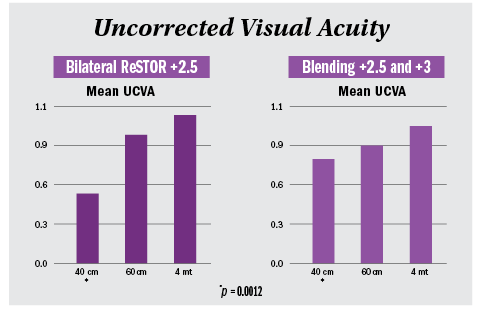Article
Multifacets of a multifocal IOL
A new +2.5 D add version of a multifocal IOL features a re-designed optic that enhances visual function at intermediate and distance and delivers excellent visual quality.
TAKE HOME:
A new +2.5 D add version of a multifocal IOL features a re-designed optic that enhances visual function at intermediate and distance and delivers excellent visual quality.
Francesco Carones, MD, of Milan, Italy, shares his personal and real patient experiences, along with insights he has obtained using the AcrySof IQ ReSTORE +25 D IOL (Alcon Laboratories).
Milan-A new +2.5 D add version of a multifocal IOL enhances the ability of cataract surgeons to meet the diverse vision needs of their patient population.
Francesco Carones, MD, described the design and attributes of the acrylic aspheric apodized diffractive multifocal IOL (AcrySof IQ ReSTOR +2.5, Alcon Laboratories). He also discussed his experience with implanting the lens bilaterally or in a mixed approach, using the +2.5 D add multifocal IOL in the dominant eye and the near distance-optimized +3 D add multifocal IOL in the non-dominant eye.
Compared with the +3 D version of the apodized diffractive multifocal IOL, the +2.5 D lens distributes more light energy for distance. It has a larger central zone with a refractive versus diffractive design, noted Dr. Carones, medical director, Carones Ophthalmology Center, Milan.
In addition, the apodized diffractive zone of the +2.5 D IOL features fewer graduated steps over a smaller diameter compared with the +3 D IOL. Whereas the +3 D IOL has 9 steps over a 3.6-mm diameter, the +2.5 D add IOL apodized diffractive zone has 7 steps over a 3.4-mm diameter. The +2.5 D add IOL also has more negative asphericity than the +3 D version, –0.2 versus –0.1 μm.
“The +2.5 D add multifocal IOL provides distance vision quality and contrast sensitivity performance that is comparable to a monofocal IOL, intermediate vision and night vision quality that is better than with the +3 D add multifocal IOL, and good functional near vision exceeding that achieved with a monofocal IOL,” Dr. Carones said.
“With these features, the +2.5 D add multifocal IOL is especially well-suited for patients seeking a range of uncorrected vision better than that achieved with a monofocal IOL, who are concerned about quality of vision, but whose primary vision needs are for distance and intermediate tasks,” he said.
Visual needs as determining factor

Figure courtesy of Francesco Carones, MDBecause the +2.5 D and +3 D versions of the multifocal IOL each have unique benefits, decisions on whether to implant one or the other bilaterally or both in a blended approach depend on the patient’s visual needs, Dr. Carones noted. The selection is guided by patient responses to a lifestyle questionnaire that is designed to determine an individual’s vision preferences and goals. Other factors considered include the patient’s age and height, as generally patients who are younger or taller may do better with bilateral implantation of the +2.5 D IOL.
“However, with proper IOL selection, satisfaction has been high whether patients [undergo implantation] bilaterally with either lens or . . . with a blended approach,” Dr. Carones said.
Bilateral or blended approach?

Dr. CaronesAmong 14 patients with the +2.5 D add multifocal IOL implanted bilaterally, all had binocular uncorrected visual acuity (UCVA) that was 20/20 or better at distance, 20/20 or better at intermediate (60 cm), and 20/50 or better at near (40 cm), while 5 (36%) patients achieved 20/20 near UCVA.
Thirty-six patients undewent implantation with a blended approach, receiving the +2.5 D add IOL in the dominant eye and the +3 D add IOL in the non-dominant eye. In binocular UCVA testing, all achieved 20/20 or better at distance, whereas 89% saw 20/20 or better at intermediate. Binocular near UCVA was 20/32 or better in all eyes and 20/20 in 75%.
“These results show how the blended approach can increase spectacle independence for patients, but based on patient reports, it does so without significantly decreasing quality of vision or increasing visual symptoms,” Dr. Carones said.
The +2.5 D add AcrySof IQ ReSTOR multifocal IOL will be launched later this year in Europe. It has not yet been approved by the FDA.
Francesco Carones, MD
Dr. Carones is a consultant for Alcon Laboratories. This article was adapted from Dr. Carones’ presentation during the 2013 meeting of the American Society of Cataract and Refractive Surgery.
Subscribe to Ophthalmology Times to receive the latest clinical news and updates for ophthalmologists.
Newsletter
Don’t miss out—get Ophthalmology Times updates on the latest clinical advancements and expert interviews, straight to your inbox.




